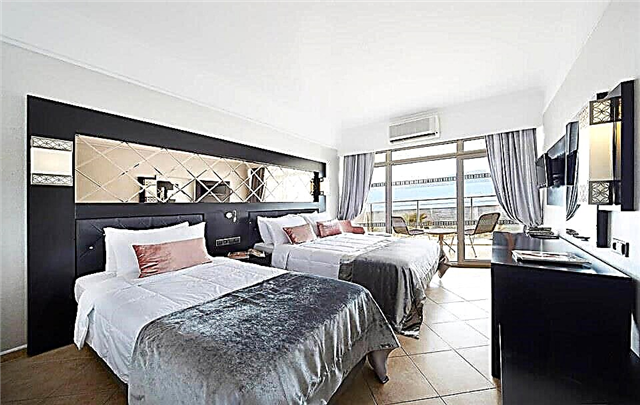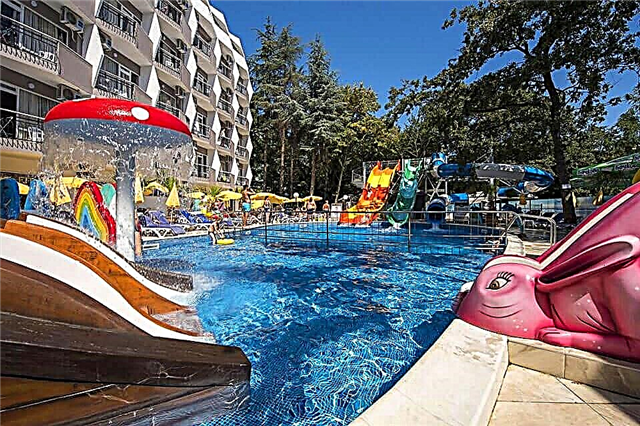Among the four surviving Orthodox monasteries in Kazan, the monastery in honor of John the Baptist stands out for its special beauty and article. The unique architectural ensemble is included in the UNESCO World Heritage List, so it is not missed by any city tour.
The history of the monastery
According to the scribal book of the 16th century in 1567, Archbishop German of Kazan founded near the walls Kazan Kremlin courtyard of the Sviyazhsky Assumption Monastery. In 1594, by the decision of Metropolitan Hermogenes of Kazan, this courtyard was transformed into an independent male monastery in honor of John the Baptist. The decree on the appointment of the abbot was signed by the Russian Emperor Fyodor Ioannovich himself.

John the Baptist Monastery from a bird's eye view
The first wooden cells in the monastery appeared in the 17th century. Such buildings were short-lived, so after a great fire in 1649, the monastery was rebuilt from stone. A lot of money for this was allocated by the eminent Kazan merchant Gabriel Fedorov-Antipin. The generous philanthropist had his own courtyard nearby, and often came to the monastery to pray.
In just three years, a harmonious architectural ensemble has grown in the city center - a majestic three-hipped cathedral, an elegant five-domed temple and a high octahedral bell tower. They looked so harmoniously next to each other that people even from the suburbs of Kazan came to admire the monastery.

View of the western gate of the St. John the Baptist Monastery
Throughout history, the monastery was small and poor. In the middle of the 18th century, she had tiny land plots and owned 90 serfs. According to the church reform, which was carried out by Empress Catherine II, they wanted to abolish the John the Baptist Monastery, but the local archbishop, Metropolitan Benjamin, managed to defend the monastery. The monastery was preserved, but taken out of the state, that is, left without financial support from the state.
In 1815, a strong fire broke out in Kazan, which damaged 1,179 houses and many monastery buildings. Residents of the city collected 53 thousand rubles for the restoration of their beloved monastery, and Emperor Alexander I allocated another 5 thousand rubles from his personal funds.

View of the St. John the Baptist Monastery from the Millennium Square
At the end of the 19th century, the dilapidated cathedral was demolished. A new five-altar cathedral church was built in the vacant space according to the project of the architect GB Rusch. The builders completely repeated the appearance of the old cathedral, but made the church larger and more representative. Like the previous temple, the renovated Cathedral of the Baptist was completed by three tents, but it was much higher and more spacious. The construction turned out to be quite costly and cost 100 thousand rubles.
At the beginning of the last century, the monastery flourished. Its abbot was a graduate of the Vologda Theological Academy, Archimandrite Ekzakustodian (Kamensky), and wealthy Kazan merchants allocated funds for the maintenance. The abode owned arable and hay lands, fishing grounds, forest lands and a flour mill. In addition to two temples, the monastery had three stone buildings and solid stone cellars.

View of the Church of the Entry into the Temple of the Blessed Virgin of the Ioanno-Baptist Monastery
In 1918, the territory of the Kazan Kremlin was turned into a military town, so the diocesan administration moved to the St. John the Baptist monastery. In November 1923, the authorities arrested the hieromonks and the hierodeacon and sent them to a concentration camp for 3 years. Solovki... By this time, the monastery community consisted of 100 people. In 1927, the buildings were handed over to the "renovationists", but soon the monastery was finally liquidated.
The beautiful three-hipped Baptist Church, a monastery chapel and a solid stone fence with a gate were destroyed in the 1930s. Brick was used as a building material for the renovation of the walls of the Kazan Kremlin. Together with the Baptist Cathedral, the unique archive of the Kazan Theological Academy, which was kept there, disappeared.

View of the Church of the Presentation of the Most Holy Theotokos and the cell building from the territory of the monastery
After the monastery was abolished, a shelter for street children existed within its walls for several years. Then the former monastery was converted into living quarters, and some of the buildings were given to the Committee for the Protection of Monuments and various cooperative offices.
It must be said that the tenants lived in the monastery in very difficult conditions. Unrepaired emergency buildings, which are more than three centuries old, were severely frozen in winter. There were no amenities inside, and the roofs leaked with every rain.

View of the domes of the Church of the Presentation of the Most Holy Theotokos in the Temple
In 1992, the territory of the monastery was returned to the believers. The diocese began a long restoration of the shrine. The recovery process was not easy. The construction of the Kazan metro caused great damage to the monastery.
When a huge foundation pit was dug in the city center, large cracks appeared on the walls of the old Vvedenskaya church. There was a threat of the collapse of the temple. To prevent the monastery from "slipping" into the pit prepared for the Kremlin metro station, deep piles had to be driven into the ground. Church services in the Vvedensky Church were resumed only in 1994.

View of the monastery bell tower from the side of the Church of the Presentation of the Most Holy Theotokos in the Temple
Architectural features and shrines
Connoisseurs of Russian temple architecture consider the ancient monastery to be one of the most significant sights of Kazan. In addition to the cathedral church, all the monastery buildings of the 17th century have been preserved here, and from them one can judge how the city center looked more than three and a half centuries ago. Kazan builders did a great job - the old stone buildings still look perfect today.
A low three-tiered bell tower in the Baroque style, the upper tier of which is decorated with keeled kokoshniks, is considered an impressive monastery monument. It stands in the very center of the monastery. A large cracked bell and a stone cross can be seen in front of the bell tower. The tablet below says that several metropolitans and archimandrites found their last rest here.

View of the monastery bell tower from the Kazan Kremlin
Tourists love the elegant five-domed Church of the Presentation of the Mother of God in the Temple, which is located near Profsoyuznaya Street. The pillarless temple was one of the first to be erected in the monastery. It is adorned with a decor typical of the mid-17th century - figured bricks architraves. Openwork gilded crosses flaunt on small green domes.
Inside, in a special tomb, a part of the relics of St. Herman of Kazan is kept, and on the walls hang the image of John the Baptist, the revered icons of the Mother of God "Inexhaustible Chalice" and "Tikhvin". The Vvedenskaya Church is adjoined by a three-storey stone building of fraternal cells.

View of the archimandrite building
From the old buildings on the territory there are a two-story fraternal building near Gostiny Dvor and an archimandrite building, the facade of which overlooks Profsoyuznaya Street. A neat two-storey building with white-stone platbands and columns was built at the end of the 19th century according to the project of the architect P.M. Tyufilin.
Useful information for pilgrims and tourists
John the Baptist Monastery has a special status in the diocese. The residence of the Kazan bishop is located here, therefore the rector of the monastery is the ruling bishop. In terms of importance, the John the Baptist Monastery ranks second after the famous Raifskaya Mother of God monastery. He is known for his charity work. There is the only free dining room in the city for the poor on the territory.

Worship cross at the walls of the monastery bell tower
Church services in the Vvedensky Church are held twice a day - at 8:10 and 17:00. Monks teach Sunday school and work in the library. A hotel with a refectory is open for pilgrims. If you want to buy Orthodox literature, an icon, a cross or incense, take a look at the monastery shop.
The territory of the monastery is one of the most comfortable and well-groomed in the diocese. From May until late autumn, visitors enjoy the luxurious flower gardens. The beautiful flowers are planted at different levels and slopes, and are reminiscent of the famous “hanging gardens". The roses, which bloom every year under the windows of the abbot's building, and the staircase drowning in flowers, leading from the gate to the Vvedensky temple, look spectacular.

How to get there
The ancient monastery is located in the historical center of the city, on Bauman Street, 2. Spasskaya Tower of the Kazan Kremlin... From the metro station "Kremlevskaya" to the entrance to the monastery a couple of minutes walk.
Attraction rating:











